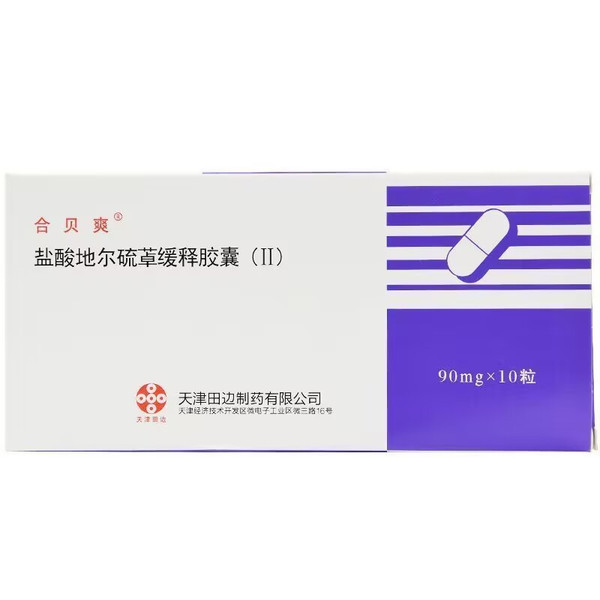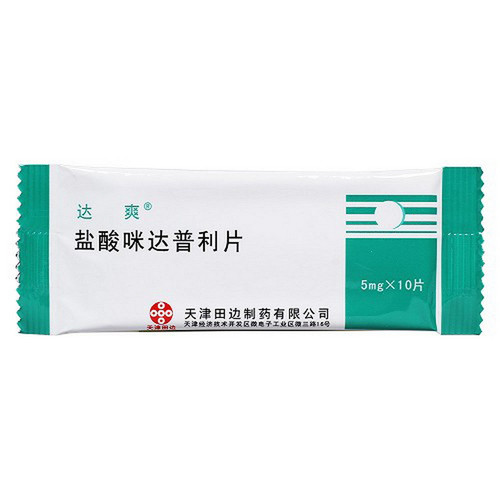Product Overview
[Drug Name]
Generic Name: Diltiazem Hydrochloride Sustained-Release Capsules (II)
Trade Name: Hebeishuang Diltiazem Hydrochloride Sustained-Release Capsules (II) 90mg*10s
Pinyin Full Code: HeBeiShuang YanSuanDiErLiuZhuoHuanShiJiaoNang (II) 90mg*10s
[Main Ingredient]
The main ingredient of this product is diltiazem hydrochloride. Chemical Name: cis-(+)-5-[(2-dimethylamino)ethyl]-2-(4-methoxyphenyl)-3-acetoxy-2,3-dihydro-1,5-benzothiazepine-4(5H)-one hydrochloride. Molecular Formula: C22H26N2O4S·HCl. Molecular Weight: 450.99
[Properties]
This product is a capsule containing small white granules.
[Indications/Main Functions]
For mild to moderate hypertension and angina pectoris.
[Precautions]
1. This drug may prolong the refractory period of the atrioventricular node, but does not significantly prolong sinus node recovery time, except in sick sinus syndrome. Rarely, this effect may abnormally slow the heart rate (particularly in patients with sick sinus syndrome) or cause second- or third-degree atrioventricular block. Combination use of this drug with beta-blockers or digitalis may result in a synergistic effect on cardiac conduction slowing. A case of cardiac arrest of 2-5 seconds after oral administration of 60 mg of this drug has been reported in a patient with variant angina. 2. This drug has a negative inotropic effect. Experience with its use alone or in combination with beta-blockers in patients with impaired ventricular function is limited; therefore, caution should be exercised in these patients. 3. The maximum antihypertensive effect of this drug is usually achieved after 14 days, and its use may occasionally cause symptomatic hypotension. 4. Acute liver damage has rarely occurred with this drug, manifested by markedly elevated levels of alkaline phosphatase, lactate dehydrogenase, aspartate aminotransferase, and alanine aminotransferase, as well as other signs of acute liver damage. Recovery is possible with discontinuation of the drug. 5. This drug is metabolized in the liver and excreted by the kidneys and bile. Long-term use requires regular monitoring of liver and kidney function. Patients with impaired liver and kidney function should use this drug with caution. 6. Skin reactions are mostly transient and resolve with continued use. There have been rare reports of skin reactions progressing to erythema multiforme and/or exfoliative dermatitis. If skin reactions persist, the drug should be discontinued. 7. Because this drug may interact synergistically with other medications, caution should be exercised when used concomitantly with medications that affect cardiac contractility and/or conduction, and the dosage should be carefully adjusted. 8. This drug undergoes biotransformation via cytochrome P450 oxidase in the body. Coadministration with other drugs that undergo biotransformation via the same pathway may result in competitive inhibition of metabolism. Therefore, when starting or stopping concomitant use of this drug, the dosage of drugs involved in the same metabolic pathway, particularly those with a low therapeutic index or in patients with impaired liver and kidney function, should be adjusted to maintain appropriate blood drug levels.
[Drug Interactions]
1. Sick Sinus Syndrome in patients without a pacemaker. 2. Patients with II or III degree atrioventricular block without a pacemaker. 3. Patients with systolic blood pressure below 12 kPa (90 mmHg). 4. Patients with allergies to this product. 5. Patients with acute myocardial infarction or pulmonary congestion.
[Pediatric Use]
The safety and efficacy of this product in children have not been established.
[Elderly Use]
No clinical data are available for its use in the elderly, but it is recommended that elderly patients start with half the normal dose.
[Pregnant and Lactating Women Use]
There are no controlled trial data on the use of this product in pregnant women, so the risks and benefits of using this product should be carefully considered. This product is excreted in breast milk, and its concentration is close to the blood concentration. If a lactating woman needs to use this product, she should discontinue breastfeeding.
[Specifications]
90 mg x 10 seconds
[Dosage and Administration]
Oral. Take one tablet once or twice daily. If the dose needs to be increased, the daily dose should not exceed 360 mg, taken in divided doses, but only under the guidance of a physician.
[Adverse Reactions]
1. Common adverse reactions: edema, headache, nausea, dizziness, rash, weakness. 2. Rare adverse reactions (<1%): (1) Cardiovascular system: angina pectoris, arrhythmia, atrioventricular block, bradycardia, bundle branch block, congestive heart failure, electrocardiogram abnormalities, hypotension, palpitations, syncope, tachycardia, ventricular premature beats. (2) Nervous system: dreaminess, amnesia, depression, abnormal gait, hallucinations, insomnia, nervousness, paresthesia, personality changes, drowsiness, tremor. (3) Digestive system: anorexia, constipation, diarrhea, taste disturbance, indigestion, thirst, vomiting, weight gain, mild increase in alkaline phosphatase, lactate dehydrogenase, aspartate aminotransferase, and alanine aminotransferase. (4) Skin: petechiae, photosensitivity, itching, urticaria. (5) Others: amblyopia, elevated CPK, dry mouth, dyspnea, epistaxis, irritability, hyperglycemia, hyperuricemia, impotence, muscle spasm, nasal congestion, polyuria, increased nocturia, tinnitus, osteoarthritis, alopecia, erythema multiforme, extrapyramidal syndrome, gingival hyperplasia, hemolytic anemia, prolonged bleeding time, leukopenia, purpura, retinopathy, thrombocytopenia, exfoliative dermatitis.
[Contraindications]
1. Patients with sick sinus syndrome who do not have a pacemaker installed. 2. Patients with II or III degree atrioventricular block who do not have a pacemaker installed. 3. Systolic blood pressure below 12 kPa (90 mmHg). 4. Patients who are allergic to this product. 5. Patients with acute myocardial infarction or pulmonary congestion.
[Overdose]
The reported dose range for overdose of this product is less than 1g to 10.8g. Overdose of this product may cause bradycardia, hypotension, heart block and heart failure. While the drug is being cleared from the gastrointestinal tract, the following treatments can be administered based on its pharmacological effects and clinical experience: 1. Bradycardia: Administer atropine 0.6-1 mg. If ineffective, use isoproterenol with caution. 2. High-grade atrioventricular block: Treat as above. If persistent high-grade atrioventricular block occurs, administer a pacemaker. 3. Heart failure: Administer inotropic drugs (isoproterenol, dopamine, dobutamine) and diuretics. 4. Hypotension: Administer pressors (such as dopamine or norepinephrine).
[Pharmacology and Toxicology]
1. Pharmacological Action: This drug is a calcium channel blocker. Its action is related to inhibiting calcium influx during myocardial and vascular smooth muscle depolarization. This drug effectively dilates epicardial and subendocardial coronary arteries, relieving spontaneous angina or angina caused by ergonovine-induced coronary artery spasm. By slowing heart rate and lowering blood pressure, it reduces myocardial oxygen demand, increases exercise tolerance, and relieves exertional angina. This drug relaxes vascular smooth muscle, decreases peripheral vascular resistance, and lowers blood pressure. The extent of the blood pressure reduction depends on the degree of hypertension; in normotensive individuals, it only causes a slight decrease in blood pressure. This drug has a negative inotropic effect and may slow conduction in the sinoatrial and atrioventricular nodes. 2. Toxicological Effects: Carcinogenic, mutagenic, and reproductive toxicity have been reported in rats administered this drug for 24 months and in mice administered this drug for 21 months. No carcinogenic effects were observed in in vitro bacterial studies. Animal studies have confirmed no significant effect on fertility.
[Pharmacokinetics]
After oral administration, this drug is relatively completely absorbed from the gastrointestinal tract (up to 92%). Following a single 120 mg oral dose, plasma concentrations become measurable 2-3 hours after administration, with peak plasma concentrations reaching 6-11 hours. The apparent elimination half-life after single or repeated oral doses is 5-7 hours. When the daily dose is increased from 120 mg to 240 mg, the AUC increases 2.6-fold. When the daily dose is increased from 240 mg to 360 mg, the AUC increases 1.8-fold. Only 2-4% of the original drug is excreted in the urine. Plasma protein binding is 70-80%. The minimum effective plasma concentration is 50-200 ng/mL.








